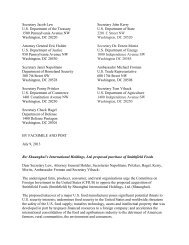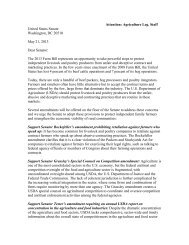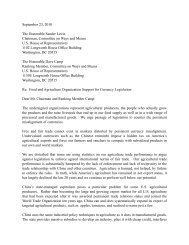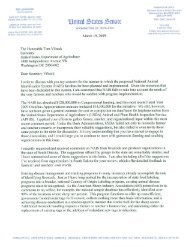Exhibit 8, 100416 Brazil FMD Risk Evaluation - R-Calf
Exhibit 8, 100416 Brazil FMD Risk Evaluation - R-Calf
Exhibit 8, 100416 Brazil FMD Risk Evaluation - R-Calf
You also want an ePaper? Increase the reach of your titles
YUMPU automatically turns print PDFs into web optimized ePapers that Google loves.
holding and begin tracing animal movement on and off the premises during the 60 days prior to the<br />
likely beginning of the sanitary problem (30 days for CSF) [4, 7].<br />
Following laboratory confirmation, the LVU declares a state of sanitary emergency and recruits the<br />
civilian defense and military forces to the effort. In addition, other States, neighboring countries,<br />
trading partners, and international organizations are notified of the outbreak [19].<br />
Upon confirmation of disease the trace investigation is expanded to include the transit of people,<br />
transportation of products, fairs, abattoirs, and buyers who, before the imposition of the restrictions,<br />
had been in contact with the infected establishment. All professionals who work with animals inside<br />
the infected zone are informed of the occurrence of disease and are required to provide the official<br />
veterinary service with a list of all breeding establishments visited during the last 7 days [3].<br />
Ongoing sanitary emergency actions also include defining an emergency area around the affected<br />
holding at least 25 km in radius, restricting the transport of animals, animal products, and byproducts<br />
in the emergency area (as well as those related commercially to the affected holding), and banning<br />
agricultural and livestock events (shows, markets, auctions, and similar events) in the emergency<br />
area. The emergency area is subdivided into three areas, which are, in order of decreasing severity,<br />
the infected area, the surveillance area, and a buffer or protection area [4].<br />
The infected area includes the affected holding plus all other holdings within a minimum radius of<br />
3 km from the outbreaks. Within this area the movement of animals, people, and vehicles onto and<br />
off holdings is prohibited. Sick and contact animals must be destroyed (using compensation funds),<br />
and all places where the sick and contact animals had been held must be cleaned and disinfected [4].<br />
The surveillance area includes all holdings located within 7 km of the infected area. Animal<br />
movements are banned within this area, although animals may be slaughtered for internal<br />
consumption only (i.e., in slaughterhouses located within the surveillance zone itself) following<br />
approved biosecurity measures. Slaughter, when authorized, must be supervised by the official<br />
veterinarian and the meat boned with the bones incinerated. All susceptible animals must receive a<br />
clinical inspection, and surveillance and monitoring of this population must be constant.<br />
Surveillance must include serological evaluation of all susceptible animals within the infected zone<br />
[4].<br />
The buffer area surrounds the infected and surveillance areas and extends 15 km beyond the outer<br />
limits of the surveillance area. Measures taken within this zone include restrictions on animal<br />
transport, slaughter of animals for internal consumption only (in local abattoirs) as above, and<br />
ongoing surveillance, including clinical inspection of susceptible animals [4].<br />
Cleaning and disinfection of affected premises starts with removal of any excess organic matter.<br />
The area is then cleaned with water under pressure. All the material collected during this stage,<br />
including food, excreta, and effluents, must be destroyed (buried or incinerated). The facilities are<br />
washed again with detergents, followed by a preliminary disinfection after the facilities and the<br />
waste-collecting gutters have dried. The process is repeated as many times as the official service<br />
deems necessary. Machinery, equipment, and materials used to end the outbreak are also disinfected<br />
[3].<br />
APHIS <strong>Evaluation</strong> of the Status of the <strong>Brazil</strong>ian State of Santa Catarina 59











